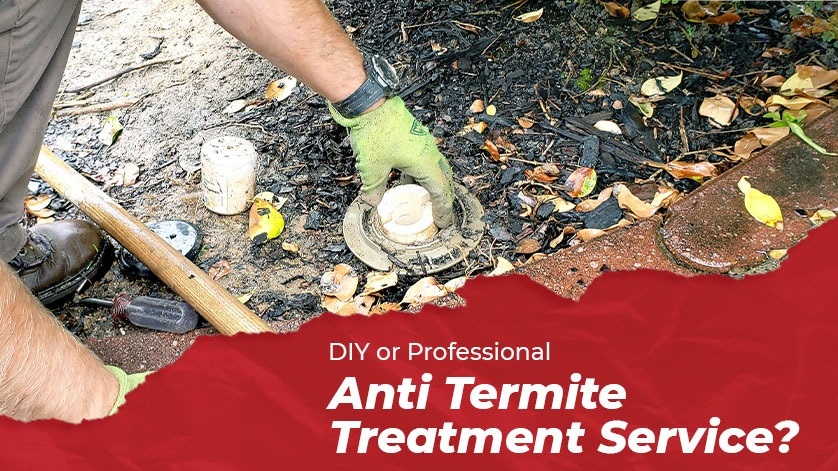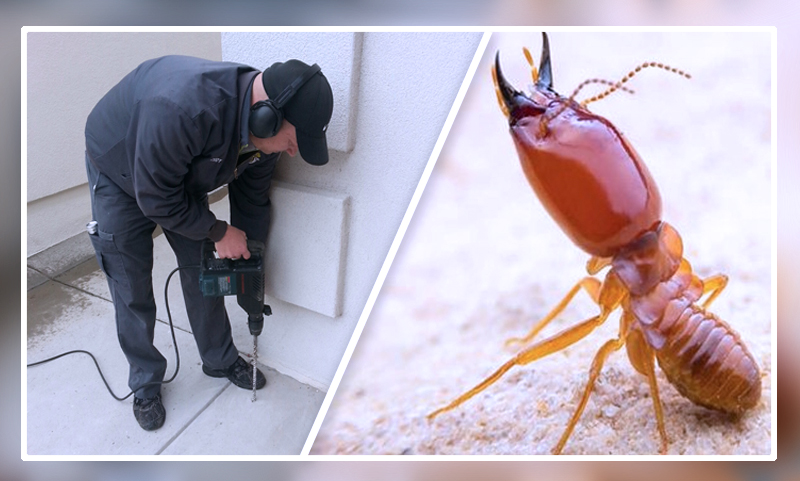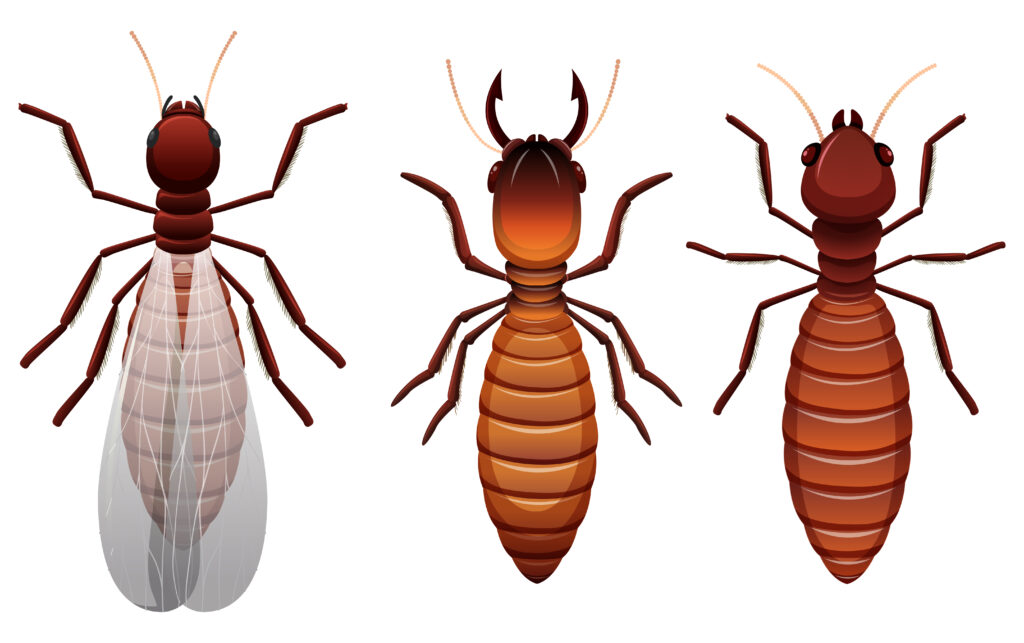
Termite Control & Prevention Solutions "Protect your property from one of the most destructive pests—termites. We offer comprehensive termite solutions, including inspection, prevention, and treatment. Our advanced techniques target colonies at their source, safeguarding your home or business from costly structural damage. Whether it's a one-time treatment or ongoing prevention, trust us to keep your property termite-free."
Termite Control & Prevention Solutions "Protect your property from one of the most destructive pests—termites. We offer comprehensive termite solutions, including inspection, prevention, and treatment. Our advanced techniques target colonies at their source, safeguarding your home or business from costly structural damage. Whether it's a one-time treatment or ongoing prevention, trust us to keep your property termite-free."
Types of Termites: 1. Subterranean Termites: These are the most common and destructive type, building colonies underground and accessing wood through mud tubes. 2. Drywood Termites: They infest dry wood, like in walls or furniture, and don’t require contact with soil. 3. Dampwood Termites: These termites prefer moist wood, often found in areas with high humidity or water damage.


Termites can cause significant damage before their presence becomes obvious, so early detection is crucial. Here are some common signs of a termite infestation to watch for:
A termite inspection is essential for detecting termite activity early and preventing structural damage to your property. Here's a guide on what to expect and how it works:


Termite control is crucial to protecting your property from costly damage. Termites, especially subterranean and drywood types, can silently eat away at your building's structure. Effective termite control involves a combination of prevention, inspection, and targeted treatments.
If you're looking to monitor and manage termites on your own, there are some DIY tips that can help you detect termites early and prevent an infestation from worsening. While professional services are recommended for severe cases, these monitoring techniques can be effective for early detection and prevention:
DIY Termite Bait Stations • How It Works: You can make simple bait stations using untreated wood or commercially available termite baits. • How to Set Up: o Bury wood stakes or cardboard in soil around your property, particularly near the foundation, in moist areas, or where termites are likely to enter. o Check the bait stations every 2–4 weeks for signs of termite activity, such as damaged or hollow wood. o If termites are found, this indicates a nearby colony, and it's time to call in professionals for treatment.


Termites can enter homes through several hidden pathways, making it difficult to detect them until they've caused significant damage. Understanding how termites access your home is key to preventing an infestation.
Termites are small, social insects that live in colonies and feed on cellulose, a component of wood. They are known for causing damage to buildings, furniture, and other wooden structures.
Termites have soft bodies and range in color from white to light brown. Workers are usually pale, while reproductive termites (swarmers) are darker and have wings. They can look similar to ants, but their bodies are not segmented like ants.
Signs of termite infestation include: • Mud tubes on walls or foundations • Hollow-sounding wood • Discarded wings near windows or doors • Droppings (termite frass) that look like small wood pellets • Buckling paint or wood that appears damaged
Termites are attracted to: • Moisture, which can come from leaks or poor drainage • Wood in direct contact with soil • Unsealed cracks in foundations or walls • Dead trees or wood debris near the home
Termites do not bite humans, and they are not known to spread diseases. However, they can cause significant structural damage, which can lead to expensive repairs.
The main types of termites include: • Subterranean termites: The most common, they live in the soil and build mud tubes to access food sources. • Drywood termites: Found in drier wood above ground, often in attics and furniture. • Dampwood termites: Preferring moist wood, they are usually found in damp or decaying areas.
Termite damage depends on the size of the colony and the type of wood. A large colony can eat through a significant amount of wood within months, potentially causing extensive damage within a year.
DIY termite treatments are available, but professional pest control is often recommended for effective termite management, especially for larger infestations or subterranean termites that are difficult to reach.
Professional treatments include: • Termiticide barriers: Applying liquid chemicals in the soil around the home to create a barrier. • Bait systems: Installing bait stations to attract and kill termites. • Fumigation: Using gas to eliminate termites in an entire structure (often for drywood termites). • Wood treatments: Applying borates or other chemicals to wood surfaces to deter termites.
To prevent termites, you should: • Fix leaks and ensure proper drainage around your home • Keep woodpiles away from the foundation • Seal cracks in the foundation and around windows • Ensure proper ventilation in crawl spaces and attics • Regularly inspect your home for signs of termites
Termites are more common in warmer, humid climates, but they can be found in nearly every state and many countries around the world.
If you suspect termite activity, contact a professional pest control service for an inspection and possible treatment. Early detection can help minimize the damage.


Termite control services often use a variety of methods and products to eliminate and prevent infestations. These methods do not typically involve spices, but they can include various chemicals, baits, and treatments.
Renewing termite service typically refers to continuing pest control services after an initial treatment has been performed. This renewal can include inspections, preventative treatments, and monitoring for any signs of termite activity.


"Effective Termite Solutions to Protect Your Property Termites can cause extensive damage to your property, and their ability to thrive in hidden and hard-to-reach areas make them a major headache for homeowners and businesses. Generic termite sprays and DIY treatments may not provide a long-term solution, especially against large termite colonies. To get rid of termites for good, it's best to rely on expert termite control services from a reputable pest control company. Our trained technicians use advanced techniques and treatments to eliminate termites and prevent future infestations, giving you peace of mind and protecting your valuable assets."

Termites are a group of insects that consume dead plant materials and can digest cellulose. Subterranean termites are the most destructive wooden pests, constructing their colonies in soil and reaching wood or any other cellulose source above ground level. These pests can cause significant damage to door frames, kitchen cabinets, staircase, and wooden flooring over time.
Post-construction termite treatment is essential to protect your property from termite damage. At Pest Homes, our expert team uses the latest surveying and treatment techniques to ensure your home or workplace is protected from the harmful effects of termites. Our safe and approved treatment methods provide long-term protection plans tailored to your needs, and we take the utmost care to safeguard your assets. Choose our Post Construction Termite Treatment and get the right services for your termite problems.

Detecting termite infestations can be challenging as they prefer dark, humid and concealed environments. Often, termite damage becomes apparent only after significant destruction has occurred. However, certain signs can indicate their presence. Look for small flying insects, known as termite swarmers, near windows during spring. Discarded wings around your home can also be a sign of termite activity. Since termite swarmers resemble flying ants, accurate identification is crucial. Termites can live undetected for years in hollow doors and wall voids. Visible property damage is another indicator of their presence. Early signs of termite infestations should be addressed promptly with professional customized solutions to prevent further damage to your property.

Before conducting any termite treatment, "Pest Homes" performs a thorough survey to identify any existing or potential termite infestations. Our skilled specialists conduct a comprehensive termite assessment of all accessible areas using state-of-the-art technology such as Termatrac and Thermal Imaging Camera. These devices use moisture, thermal, and radar sensors to detect termites in places that are not visible to the human eye. Our certified termite experts conduct a meticulous inspection of your home, both inside and out, to carefully look for evidence of termite activity and potential access points. An annual termite inspection by "Pest Homes" is the best way to protect your property from serious termite damage by providing early detection of termite activity. With termites, it is often difficult to detect infestations without professional assistance. If you're searching for a termite inspection near you, "Pest Homes" offers a free inspection to provide you with all the information you need before making a decision.

Termites can cause significant damage to your property, making them troublesome pests to deal with. Their discreet and inaccessible nature makes termite control particularly challenging. While DIY anti-termite treatments like termite spray may seem like a cost-effective solution, they may not be able to treat termite infestations at the root level, especially when dealing with large termite colonies. To effectively remove termites from your home or workplace and safeguard your valuable belongings, it's best to seek professional termite treatment from an expert pest control brand. One tell-tale sign of a termite infestation is flying termites in the house or emerging from the foundation of a wall. Other signs include mud tubes on walls, hollow sounding woodwork, damaged wood or wooden furniture, and discarded termite wings. At Pest Control Co., we recommend regular monitoring of your property and surroundings to make them unfavourable for termite infestation. If you notice termites or any signs of termites, it's best to get in touch with our expert team for a comprehensive termite inspection and treatment.

Termites are notorious for infiltrating properties, and they can enter any building through tiny cracks and crevices less than 1/16 inches wide. It's essential to keep them out of your property, especially since up to six subterranean termite colonies can be present in a single acre plot, each housing millions of termites. To prevent termite infestation, here are some effective DIY monitoring tips. Remove any tree branches, debris, cellulose materials, and dead leaves around the property, as these provide an attractive food source and nesting site for subterranean termites. Repair leaking taps and pipes to reduce moisture levels, which attract termites to your property. Only use termite-treated wood in garden beds, retaining walls, or fence posts, as untreated wood attracts termites to your property. Avoid allowing climbing plants or bushy gardens to grow against the structure, as they provide termites with an undetected entry point. Remove dead trees and stumps, which are ideal sites for termites to nest in, and ensure all scaffolding wood is removed after construction, as termites can often attack it and use it to gain access to your home. Despite these proactive measures, it's still important to get your home inspected by professionals at least once a year to ensure it's free from termites.

Discover why termites are drawn to Indian homes and learn how to prevent them from causing damage with our expert termite identification methods and monitoring tips. Protect your property from a hungry termite colony by understanding the dangers and implementing effective termite control measures at home.

Looking for answers to your pest control questions? Check out our frequently asked questions (FAQs) about pest control. At “Pest Homes”, we understand that pests can be relentless and can disrupt your busy schedule. That's why we provide safe and effective pest control services tailored to your specific pest problem. Are you concerned about the safety of your family and pets during pest control treatments? Our team is trained in the safe handling and application of EPA-approved materials to provide superior results while using the least amount of pest control products possible. Wondering if you need to leave your home open during a pest control service? In most cases, it won't be necessary for you to leave your home, and we take the utmost care in the application and choice of pest control products. Is quarterly pest control necessary? Regular, ongoing pest control service is necessary to get rid of pests and keep them out of your home. Insect eggs are resistant to pesticides, so recurring service plans are necessary to break the egg and nesting patterns of insects and provide year-round protection from pests. If the bugs come back, don't worry! Your service is fully guaranteed, and we return for free to spot treat any areas of your home that need extra attention. Concerned about the cost of pest control services? Pest control prices depend on a variety of factors, and our article on pest control prices in Lee's Summit can help you evaluate pest control companies and their costs. Are you wondering whether chiggers and bed bugs are the same? While bed bug bites and chigger "bites" may look similar, the treatment for chiggers and bed bugs is completely different. Our team can identify and eliminate your pest problems before you get an infestation. Can bed bugs survive after heat treatment? Effective heat treatments can destroy each of the five bed bug instars and all of the eggs. Our “Pest Homes” Heat Treatment maintains the temperature between 120-135 degrees for a minimum of 4 hours to ensure that every bed bug and egg dies. After bed bug treatment, can you sleep in your bed? Yes! It is recommended that you wash your sheets to get rid of any bed bug shed skins or droppings, but it's not necessary since the bugs are dead. Bed bugs can infest areas of the home other than beds, such as sofas, cupboards, drawers, carpets, and even cars. Learn how to get rid of bed bugs in your car with our expert tips.

Termite infestations can cause significant damage to homes and buildings, making it essential to seek termite species control services. There are several species of termites, including subterranean, drywood, and dampwood, each with unique characteristics and behaviors that require specific treatment approaches. Professional termite control services can accurately identify the termite species present and determine the most effective treatment options. These services may include chemical treatments, baits, and physical barriers to prevent further termite damage. Subterranean termites are the most common species found in North America and often require chemical soil treatments to eliminate the colony. Drywood termites, on the other hand, typically require fumigation or localized spot treatments to remove the infestation. Dampwood termites are less common but can still cause significant damage to moist wood. Treatment for dampwood termites often involves eliminating the moisture source and replacing damaged wood. Regular inspections and preventative measures can also help prevent termite infestations before they become a significant problem. If you suspect a termite infestation, contact a professional termite species control service immediately to minimize damage and protect your property. “Pest Homes” provides comprehensive service to give you peace of mind

Termite service renewal is an essential aspect of termite control and prevention. Once a termite treatment has been completed, it's crucial to ensure that the termites don't return and cause further damage. Termite service renewal involves scheduling regular inspections and treatments to maintain the effectiveness of the initial treatment. Termite service renewal typically involves an annual inspection of the property to identify any new termite activity. If any activity is found, additional treatments may be necessary to eliminate the colony and prevent further damage. Additionally, termite service renewal may involve the installation of monitoring devices to detect termite activity early. Regular termite service renewal can save homeowners significant money in the long run by preventing costly termite damage. By catching termite activity early, treatments can be applied before extensive damage occurs. Additionally, preventative measures, such as sealing cracks and crevices, can be taken to reduce the risk of termite infestations. It's essential to choose a reputable termite control company for your termite service renewal needs. Look for a company with a proven track record of success and experience in termite control. The company should also offer warranties and guarantees for their services to ensure your peace of mind. In summary, termite service renewal is a critical aspect of termite control and prevention. Regular inspections and treatments can help protect your property from termite damage and save you money in the long run. Contact “Pest Homes” to schedule your termite service renewal today.
257, 1st Floor, Opp. PNB, M.G. Road, Sukhrali, Gurgaon-122001
